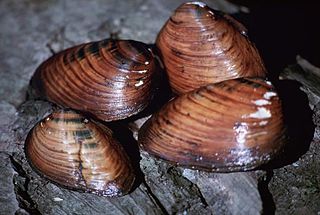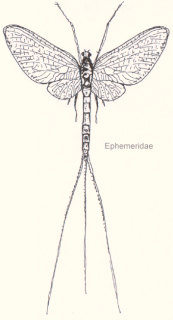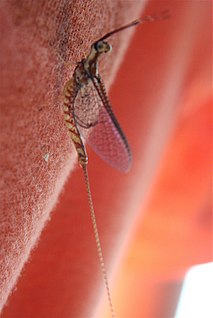
Mayflies are aquatic insects belonging to the order Ephemeroptera. This order is part of an ancient group of insects termed the Palaeoptera, which also contains dragonflies and damselflies. Over 3,000 species of mayfly are known worldwide, grouped into over 400 genera in 42 families.

Coffea canephora is a species of coffee that has its origins in central and western sub-Saharan Africa. It is a species of flowering plant in the family Rubiaceae. Though widely known as Coffea robusta, the plant is scientifically identified as Coffea canephora, which has two main varieties, robusta and nganda.

The roundtail chub is a cyprinid fish in the genus Gila, of southwestern North America. It is native to the Colorado River drainage basin, including the Gila River and other tributaries, and in several other rivers. It is part of the “robusta complex”, which includes the Gila robusta robusta, G.r. grahami, and G.r. seminuda.
The Blanco blind salamander is a species of aquatic, lungless salamander native to the United States. It is endemic to a small region of the Blanco River near San Marcos in Hays County, Texas. Its habitat, deep in limestone karst, makes collecting specimens for research particularly problematic. It is known from only a single specimen, collected in the 1950s.
Sauvagella robusta is a small species of fish in the family Clupeidae. It is endemic to the Amboaboa and Mangarahara River Basins in northern Madagascar. This relatively slender fish reaches a length of 6.8 cm (2.7 in), and is overall pale yellowish with silvery on the lower parts. Its current conservation status is unclear, but the cichlid Ptychochromis insolitus, which is highly threatened from habitat loss, is native to the same region. Sauvagella robusta is known to survive at least in Lake Tseny.

Pleurobema clava, the clubshell, club naiad or clubshell pearly mussel, is a species of freshwater mussel, an aquatic bivalve mollusk in the family Unionidae, the river mussels.
Acanthametropus pecatonica, the Pecatonica River Mayfly, is a species of mayfly in the family Acanthametropodidae. It is endemic to the Pecatonica River of Wisconsin and Illinois, with populations observed in South Carolina and Georgia.

Pentagenia, similar to Hexagenia, is a genus of insect in the family Ephemeridae, commonly referred to as burrowing mayflies.

The Philippine dawn bat is a species of megabat in the family Pteropodidae found in the Philippines.

Gomphurus externus, the plains clubtail, is a species of dragonfly in the family Gomphidae.

The popeye shiner is a North American species of freshwater cyprinid fish.

Bigeye chub is a species of freshwater fish in the carp family (Cyprinidae).
The stripetail darter is a species of freshwater ray-finned fish, a darter from the subfamily Etheostomatinae, part of the family Percidae, which also contains the perches, ruffes and pikeperches. It is endemic to the eastern United States. It is found in small rivers and streams in the states of Tennessee, Ohio, Kentucky, Illinois, Alabama, Georgia, and Mississippi. Males are a golden-orange color with black barring on the fins, and grow to a length of about 2.8 in (7 cm). This fish feeds on midge larvae and other small invertebrates. It breeds in the spring; eggs are attached to the substrate, often under slab rocks, where they are guarded by the male. The population trend of this fish seems to be stable and it is a common species with numerous sub-populations over a wide range, and the International Union for Conservation of Nature has assessed its conservation status as being of "least concern".
Percina macrocephala, the longhead darter, is a species of freshwater ray-finned fish, a darter from the subfamily Etheostomatinae, part of the family Percidae, which also contains the perches, ruffes and pikeperches. It is found in North America where it occurs in the basin of the Ohio River from New York and North Carolina west as far as western central Kentucky and Tennessee. Its preferred habitat is rocky pools with a strong flow, usually upstream or downstream from riffles With pebbles in clear, small to medium sized rivers, it also inhabits creeks. It is carnivorous and its food is mainly small crayfishes and mayfly nymphs.

Hexagenia is a genus of mayfly in the family Ephemeridae, the common burrower mayflies.
Pentagenia vittigera is a species of riverbed burrower mayfly in the family Palingeniidae. It is found in North America.










